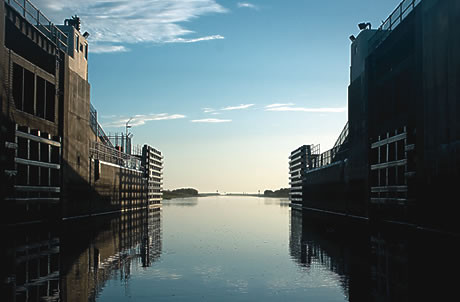SHARE:
Environment
Portrait of a Broken Lake
Forget the drought. Lake Okeechobee’s problem is too much water, not too little. Fixing it will cost as much as the multibillion-dollar plan to replumb the Everglades south of the lake.
 UNSTABLE: Rebuilding the weakened Herbert Hoover Dike will cost almost $1 billion. [Photo: Jeffrey Camp] |
By Any Name, No Cheap Fix
What once was the Lake Okeechobee watershed has a new name. The lake, the St. Lucie and Caloosahatchee estuaries and their basins now carry the more charismatic moniker of “Northern Everglades.” And while no one’s priced it down to the last pile of cow manure that will have to be cleaned up, there are indications that fixing the Northern Glades will be as pricey as restoring its similarly sized, but more famous, downstream counterpart. To clean the water, count on expensive land purchases for huge water-holding areas, use of new green technologies and planting great numbers of phosphorus-absorbing plants. It’ll cost $887 million to fix the dike alone. And people around the central Florida chain of lakes that feeds Okeechobee will want their waters safeguarded too.
“By the time it’s all said and done and you tally up what it’s going to cost, it’s probably going to be much bigger than” the comprehensive Everglades restoration, says Malcolm “Bubba” Wade Jr., a member of the South Florida Water Management District’s governing board and U.S. Sugar senior vice president.
Gov. Charlie Crist in June signed a law extending Save Our Everglades trust fund spending by 10 years to 2020, adding $94 million a year — to be matched by the district — for lake and estuary restoration. “This is an unbelievable commitment to keeping our state clean, to protecting our natural resources,” Crist said. “Teddy Roosevelt would be proud today of what we’re doing here in Florida.”
There will be indirect costs from more regulation too. The state is cracking down on fertilizer overuse in lawns, farmland, golf courses and other property. Soon, Florida will become only the second state, after Montana, to have statewide fertilizer regulation. The South Florida Water Management District, the region’s water manager, wants tougher regulations to force developers to set aside more land for environmental reasons, construct water-holding areas and take other steps to prevent tainted water runoff. “A lot of these nutrients have come from development, and shame on us if we restore our ecosystem to just have it degraded again because we didn’t fix the way we ask people to design and build subdivisions,” says water district Executive Director Carol Ann Wehle.
Wehle says she believes that while the Northern Everglades fix will be “in the billions,” it won’t match restoration of the Everglades proper in cost.
Audubon’s Lake Okeechobee science coordinator, Paul Gray, says studies being done for the plan that the district is required to present to the Legislature in February will provide a better handle on cleanup costs. But what is clear to Gray, after seeing the broken system’s effect on farmers, estuary communities and the fishing business, is what happens if nothing’s done. Says Gray, “The cost of not fixing is also astronomical.”























